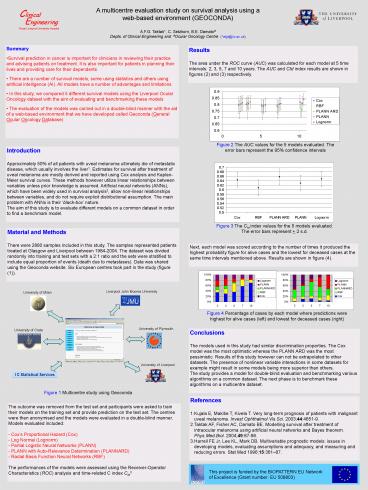A multicentre evaluation study on survival analysis using a - PowerPoint PPT Presentation
1 / 1
Title:
A multicentre evaluation study on survival analysis using a
Description:
... models using the Liverpool Ocular Oncology dataset with the aim of evaluating ... that we have developed called Geoconda (General Ocular Oncology Database) ... – PowerPoint PPT presentation
Number of Views:86
Avg rating:3.0/5.0
Title: A multicentre evaluation study on survival analysis using a
1
A multicentre evaluation study on survival
analysis using a web-based environment
(GEOCONDA) A.F.G. Taktak, C. Setzkorn, B.E.
Damato Depts. of Clinical Engineering and
Ocular Oncology Centre (afgt_at_liv.ac.uk)
- Summary
- Survival prediction in cancer is important for
clinicians in reviewing their practice and
advising patients on treatment. It is also
important for patients in planning their lives
and providing care for their dependents - There are a number of survival models, some
using statistics and others using artificial
intelligence (AI). All models have a number of
advantages and limitations - In this study, we compared 5 different survival
models using the Liverpool Ocular Oncology
dataset with the aim of evaluating and
benchmarking these models - The evaluation of the models was carried out in
a double-blind manner with the aid of a web-based
environment that we have developed called
Geoconda (General Ocular Oncology Database)
Results The area under the ROC curve (AUC) was
calculated for each model at 5 time intervals 2,
3, 5, 7 and 10 years. The AUC and Ctd index
results are shown in figures (2) and (3)
respectively.
Figure 2 The AUC values for the 5 models
evaluated. The error bars represent the 95
confidence intervals
Introduction Approximately 50 of all patients
with uveal melanoma ultimately die of metastatic
disease, which usually involves the liver1.
Estimates for survival after treatment of uveal
melanoma are mostly derived and reported using
Cox analysis and Kaplan-Meier survival curves.
These methods however utilize linear
relationships between variables unless prior
knowledge is assumed. Artificial neural networks
(ANNs), which have been widely used in survival
analysis2, allow non-linear relationships between
variables, and do not require explicit
distributional assumption. The main problem with
ANNs is their black-box nature. The aim of this
study is to evaluate different models on a common
dataset in order to find a benchmark model.
Figure 3 The Ctd index values for the 5 models
evaluated. The error bars represent 2 s.d.
Material and Methods There were 2880 samples
included in this study. The samples represented
patients treated at Glasgow and Liverpool between
1984-2004. The dataset was divided randomly into
training and test sets with a 21 ratio and the
sets were stratified to include equal proportion
of events (death due to metastases). Data was
shared using the Geoconda website. Six European
centres took part in the study (figure (1)).
Next, each model was scored according to the
number of times it produced the highest
probability figure for alive cases and the lowest
for deceased cases at the same time intervals
mentioned above. Results are shown in figure (4).
Figure 4 Percentage of cases by each model where
predictions were highest for alive cases (left)
and lowest for deceased cases (right)
Conclusions The models used in this study had
similar discrimination properties. The Cox model
was the most optimistic whereas the PLANN ARD was
the most pessimistic. Results of this study
however can not be extrapolated to other
datasets. The presence of nonlinear variable
interactions in some datasets for example might
result in some models being more superior than
others. The study provides a model for
double-blind evaluation and benchmarking various
algorithms on a common dataset. The next phase is
to benchmark these algorithms on a multicentre
dataset.
Figure 1 Multicentre study using Geoconda
- References
- Kujala E, Makitie T, Kivela T. Very long-term
prognosis of patients with malignant uveal
melanoma. Invest Ophthalmol.Vis.Sci.
2003444651-9. - Taktak AF, Fisher AC, Damato BE. Modelling
survival after treatment of intraocular melanoma
using artificial neural networks and Bayes
theorem. Phys.Med.Biol. 20044987-98. - Harrell FE Jr, Lee KL, Mark DB. Multivariable
prognostic models issues in developing models,
evaluating assumptions and adequacy, and
measuring and reducing errors. Stat Med
19961536187.
- The outcome was removed from the test set and
participants were asked to train their models on
the training set and provide prediction on the
test set. The centres were then anonymised and
the models were evaluated in a double-blind
manner. Models evaluated included - Coxs Proportional Hazard (Cox)
- Log Normal (Lognorm)
- Partial Logistic Neural Networks (PLANN)
- PLANN with Auto-Relevance Determination
(PLANNARD) - Radial Basis Function Neural Networks (RBF)
- The performances of the models were assessed
using the Receiver-Operator Characteristics (ROC)
analysis and time-related C index Ctd3
This project is funded by the BIOPATTERN EU
Network of Excellence (Grant number EU 508803)































